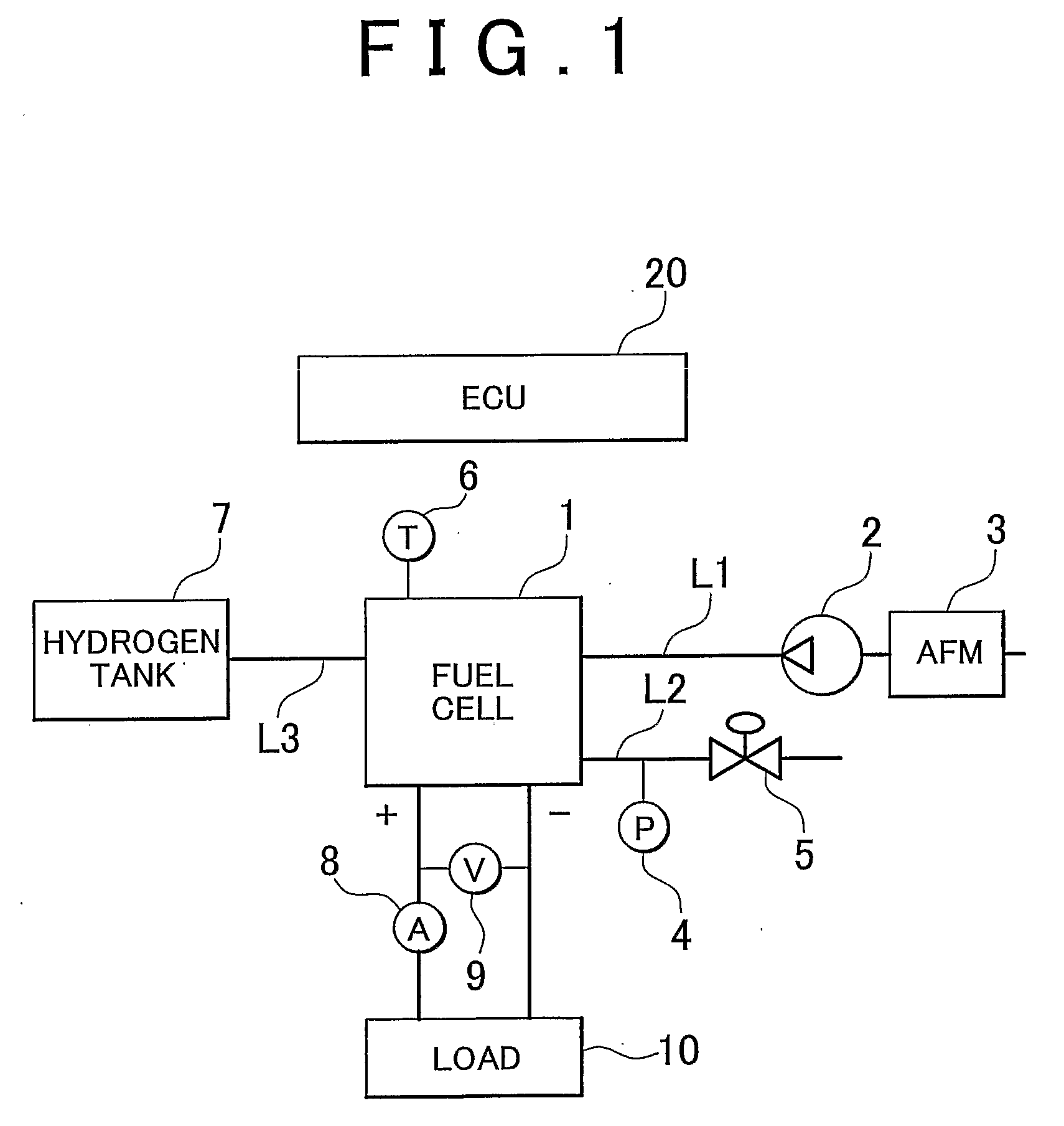Fuel cell system and method for estimating output characteristic of fuel cell
- Summary
- Abstract
- Description
- Claims
- Application Information
AI Technical Summary
Benefits of technology
Problems solved by technology
Method used
Image
Examples
first embodiment
[0037]FIG. 1 is a system configuration diagram of a fuel cell system according to the present invention. The fuel cell system has a fuel cell body 1 including a cell stack in which unit cells are stacked; an air compressor 2 that supplies air to the air electrode side in the fuel cell body 1 through an air supply passage L1; an airflow meter 3 (which may be regarded as a flow rate measuring unit) that measures the flow rate of the air supplied from the air compressor 2 to the fuel cell body 1; a pressure sensor 4 (which may be regarded as a pressure measuring unit) that measures the gas pressure on the air electrode side via a discharge passage L2 on the air electrode side of the fuel cell body 1; a pressure control valve 5 that controls the gas pressure on the air electrode side including the discharge passage L2; a hydrogen tank 7 from which hydrogen is supplied to the hydrogen electrode side in the fuel cell body 1 through a hydrogen supply passage L3; a current sensor 8 (which m...
second embodiment
[0071]FIG. 9 shows a fuel cell system of this embodiment. As compared to the fuel cell system of the second embodiment, the fuel cell system does not have the humidity sensor 12. Also, the fuel cell system has a water vapor exchange membrane type humidifier 13, with a water vapor exchange membrane that humidifies air, instead of the humidifier 11 in FIG. 6. The water vapor exchange membrane type humidifier returns the water vapor (generated water) in the off gas discharged through the discharge passage L2 on the air electrode side to the air supply passage L1 on the upstream side through an exchange membrane therein.
[0072]FIG. 10 shows an example of the relation among the airflow rate Fair in the water vapor exchange membrane type humidifier 13, the temperature Tfc of the fuel cell body 1 and the humidification amount Sair. Here, the airflow rate Fair is the flow rate in the air supply passage L1 on the upstream side.
[0073]In general, the humidification amount Sair increases as the ...
fourth embodiment
[0098]The ECU 20 then measures the AC impedance Zre(ω) of the fuel cell. This step is the same as S301 of the fourth embodiment shown in FIG. 13.
[0099]The ECU 20 then calculates the humidification amount Sair based on the flow rate from the humidity sensor or the humidifier (S210). The ECU 20 then refers a basic internal resistance R0 from the map (see FIG. 14) based on the AC impedance Zre(ω) and the humidification amount. The subsequent steps are the same as those in and after S102 in FIG. 5.
[0100]As described above, in this embodiment, a basic internal resistance R0 is determined from the AC impedance of the fuel cell and the air humidification amount with reference to a map of the relation among the AC impedance, the air humidification amount and the basic internal resistance R0. Therefore, the output characteristic of the fuel cell may be estimated with higher accuracy than in the second embodiment, in which the basic internal resistance R0 is determined simply from the humidif...
PUM
 Login to View More
Login to View More Abstract
Description
Claims
Application Information
 Login to View More
Login to View More - R&D
- Intellectual Property
- Life Sciences
- Materials
- Tech Scout
- Unparalleled Data Quality
- Higher Quality Content
- 60% Fewer Hallucinations
Browse by: Latest US Patents, China's latest patents, Technical Efficacy Thesaurus, Application Domain, Technology Topic, Popular Technical Reports.
© 2025 PatSnap. All rights reserved.Legal|Privacy policy|Modern Slavery Act Transparency Statement|Sitemap|About US| Contact US: help@patsnap.com



